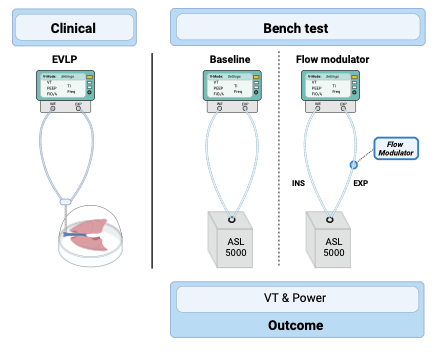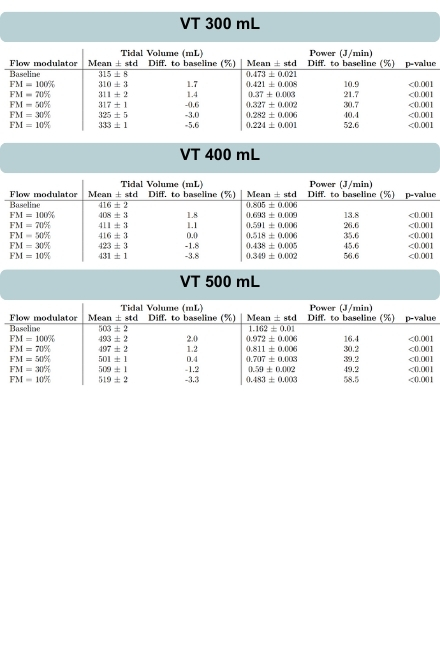Final ID: Sa1107
Resuscitation of Lungs after Cardiac Arrest with Ex-Vivo Lung Perfusion: A Bench Study to Minimize Ventilator-Induced Lung Injury through Flow Modulation
Abstract Body: INTRODUCTION – Lung donation after uncontrolled circulatory death (uDCD) following a witnessed cardiac arrest is feasible after resuscitation and assessment with ex vivo lung perfusion (EVLP). This bench study explores the efficacy of expiratory flow modulation in minimizing damage caused by mechanical power during volume-controlled ventilation within the EVLP procedure.
METHODS - Donor lungs were simulated using the ASL 5000 lung simulator (IngMar Medical) and ventilated in volume-controlled mode using the ViX-ventilator (KU Leuven), set at 7 breaths per minute with a positive end-expiratory pressure of 5 cmH2O. (Figure 1) Baseline measurements were obtained to deliver tidal volumes (VT) of 300, 400, and 500 mL. These measurements were then compared to an intervention where expiratory flow was modulated using an in-house designed device, the flow modulator. Mechanical power (J/min) was calculated using the pressure-volume curve. Differences in power between the baseline and various levels of flow modulation were assessed using a one-sided t-test.
RESULTS - No clinically relevant differences were observed in VT delivery between baseline settings and during expiratory flow modulation. (Table 1) However, significant differences in mechanical power were noted between baseline and flow modulation across the three VT settings (p<0.001). The reduction in power varied from 10.9% to 58.5%, depending on the selected VT and the degree of flow modulation applied. Notably, the extent of power reduction increased with the level of flow modulation.
CONCLUSION – Flow modulation in the expiratory circuit during volume-controlled ventilation in a bench set-up does not affect VT delivery and can significantly reduce mechanical power by up to 58.5%. This reduction in mechanical power could potentially reduce iatrogenic damage during EVLP. Consequently, this might extend preservation times and improve the resuscitation outcomes of uncontrolled DCD lungs. Emergency medicine has the opportunity to leverage this vital pool of donor lungs, moving towards a future with minimal transplant waitlists.
METHODS - Donor lungs were simulated using the ASL 5000 lung simulator (IngMar Medical) and ventilated in volume-controlled mode using the ViX-ventilator (KU Leuven), set at 7 breaths per minute with a positive end-expiratory pressure of 5 cmH2O. (Figure 1) Baseline measurements were obtained to deliver tidal volumes (VT) of 300, 400, and 500 mL. These measurements were then compared to an intervention where expiratory flow was modulated using an in-house designed device, the flow modulator. Mechanical power (J/min) was calculated using the pressure-volume curve. Differences in power between the baseline and various levels of flow modulation were assessed using a one-sided t-test.
RESULTS - No clinically relevant differences were observed in VT delivery between baseline settings and during expiratory flow modulation. (Table 1) However, significant differences in mechanical power were noted between baseline and flow modulation across the three VT settings (p<0.001). The reduction in power varied from 10.9% to 58.5%, depending on the selected VT and the degree of flow modulation applied. Notably, the extent of power reduction increased with the level of flow modulation.
CONCLUSION – Flow modulation in the expiratory circuit during volume-controlled ventilation in a bench set-up does not affect VT delivery and can significantly reduce mechanical power by up to 58.5%. This reduction in mechanical power could potentially reduce iatrogenic damage during EVLP. Consequently, this might extend preservation times and improve the resuscitation outcomes of uncontrolled DCD lungs. Emergency medicine has the opportunity to leverage this vital pool of donor lungs, moving towards a future with minimal transplant waitlists.
More abstracts on this topic:
A National Analysis Of Heart Donation After Circulatory Death In The United States
Firoz Ahad, Ebong Imo, Cadeiras Martin, Jimenez Shirin
A Multicentre Study for Hands Only CPR (HOCPR) training assessment towards building a ‘Nation of Life Savers” in IndiaRavikumar Thanjavur, Sarma Kvs, Ravikumar Thanjavur, Sarkar Manuj, Debnath Dhrubajyoti, Behera Priyamadhaba, Ghate Jayshri, Trikha Divay, Samantaray A, Madhavi K


